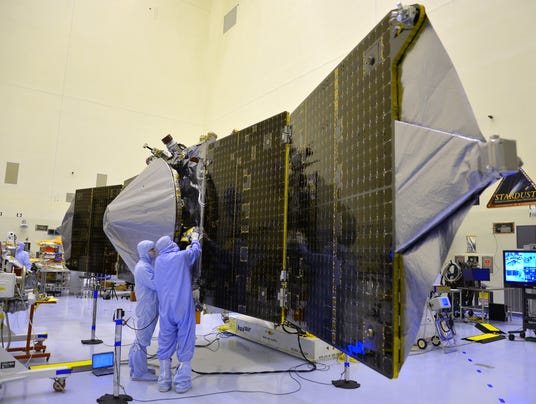Bathed in orange light and with two black solar wings outstretched, NASA's Maven spacecraft looks as if it might already be orbiting Mars.
That destination is still a year away, but the $671 million mission is approaching its Nov. 18 blastoff from Cape Canaveral Air Force Station atop an Atlas V rocket.
"We've been working on this mission for years, and we're close now, real close, and we're going to Mars, so it's really pretty cool to be at this point," said Dave Mitchell, project manager from the Goddard Space Flight Center in Greenbelt, Md.
During a media day Friday at Kennedy Space Center, where pre-launch tests are in progress, managers sidestepped questions about how a government shutdown might affect launch plans, saying they would do everything possible to stay on track.
Their schedule still has nine days of margin should technical or other problems arise, and a 20-day launch window can be extended deeper into December if necessary.
Miss that, and the mission would be grounded for two years before the right planetary alignment returned.
Unlike previous missions that have orbited, landed or roved on Mars, Maven is interested less in the planet's surface than its upper atmosphere.
Eight instruments will study the thin atmosphere and the sun's influence upon it to understand its history.
How and when did a once warm and wet planet become so cold and dry?
"It's going to tell us why the atmosphere changed over time," said Bruce Janofsky, the mission's lead scientist from the University of Colorado's Laboratory for Atmospheric and Space Physics in Boulder. "We think that the surface was conducive to supporting life 4 billion years ago, and not today, and we're trying to learn why."
Water and carbon dioxide could have been trapped in minerals and ice below the surface, Janofsky said, but a bigger driver may have been the loss of gasses through the top of the atmosphere.
Over at least a year, Maven – an acronym for Mars Atmosphere and Volatile Evolution Mission – will collect data during five "deep dips" through the upper atmosphere.
 |
| Techicians at Kennedy Space Center do final testing and preparations to the Maven spacecraft, designed to orbit Mars and make scientific measurements.(Photo: Malcolm Denemark, Florida Today) |
"We're just brushing the edge of the atmosphere," said Guy Beutelschies, project manager for Lockheed Martin Corp., which built the spacecraft and a predecessor on which it is based, the Mars Reconnaissance Orbiter.
To help control its flight, Maven's solar arrays are canted slightly like a gull's wings.
On Friday, those arrays stretched 37.5 feet from tip to tip, or about the length of a school bus, inside Kennedy Space Center's Payload Hazardous Servicing Facility, where they were recently deployed for tests.
A large, dish-shaped antenna for transmitting data to Earth was sheathed in insulation.
Before entering the ultra-clean high bay, mission and media personnel donned light blue bunny suits with masks, booties and gloves taped to their wrists, then they were "showered" with jets of air.
The precautions are taken to prevent spacecraft contamination.
Maven will be fueled in late October, enclosed in a protective fairing and moved to the launch pad in early November for placement atop a 19-story Atlas V rocket.



0 comments:
Post a Comment